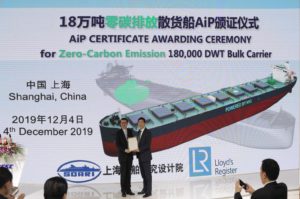Ammonia-fueled ships: entering the design phase
By Trevor Brown on December 12, 2019
Three separate projects to design a range of ammonia-fueled vessels were announced last week at a shipping industry conference in China. Lloyd’s Register has granted Approval in Principle (AiP) for the design of a 180,000 ton bulk carrier. ABS announced a project to “produce designs for an ammonia-fueled Chittagongmax container carrier of 2700 TEU capacity.” And Lloyd’s Register also announced a project for “an ammonia-fuelled 23,000 TEU Ultra-Large Container Ship (ULCS) concept design.” (TEU, or Twenty-foot Equivalent Units, is the container ship industry’s standard cargo unit.)
All three projects are working with the two-stroke ammonia engine developed by MAN Energy Solutions, and all are led by major shipbuilders in China.
The role of the classification societies, like Lloyd’s Register and ABS, is “to determine potential hazards throughout the design phase” and provide technical guidance to ensure safe and responsible design of ships. Ultimately, for any new fuel, the classification societies play a crucial role in helping to develop the codes and standards that are required to regulate its commercial use.
The fact that Lloyd’s Register, ABS, and other classification societies are swiftly moving forward with plans for ammonia-fueled vessels illustrates the speed and certainty with which the shipping industry is now accepting ammonia as a future fuel.

ABS will advise on compliance and safety considerations as MAN Energy Solutions (MAN) and the Shanghai Merchant Ship Design & Research Institute (SDARI) develop designs for a low-emission feeder container vessel.
Signed in a ceremony held at MARINTEC China, the joint development project aims to produce designs for an ammonia-fueled Chittagongmax container carrier of 2700 TEU capacity.
“Ammonia is an energy source with significant potential to help the industry meet IMO 2030 and 2050 emission targets but will require stringent new safety standards to be developed in order to support its adoption,” said Dr. Xiaozhi (Christina) Wang, ABS Vice President, Global Marine. “This innovative project is typical of how ABS is working with leading partners across the world to support the development of next generation fuel solutions for shipping.”
ABS announcement, ABS, MAN & SDARI Join Forces to Develop Ammonia-Fueled Feeder Vessel, December 5, 2019
In its own announcement on its LinkedIn page, SDARI disclosed that Lloyd’s Register had awarded it AiP for the development of a 180,000 ton bulk carrier.

Based on full research, discussion and demonstration in the early stage, also combined with the latest achievement from MAN B&W, SDARI has completed the development and design of 180,000 tons of ammonia fuel bulk carrier. The ship’s full-range ammonia fuel propulsion meets the requirements of the zero carbon emissions. SDARI will study and discuss related rules and regulations with the classification society to lay a more solid foundation for future real ship applications.
SDARI LinkedIn post, December 9, 2019
And the third announcement, this directly from Lloyd’s Register:
Lloyd’s Register (LR) has granted Approval in Principle to Dalian Shipbuilding Industry Co. (DSIC), and MAN Energy Solutions for an ammonia-fuelled 23,000 TEU Ultra-Large Container Ship (ULCS) concept design, the first ammonia as fuel design of its kind in China …
Bjarne Foldager, Senior Vice President, Head of Two-Stroke Business at MAN Energy Solutions – said: “ … Low-speed marine engines are already the most efficient propulsion system for trans-oceanic shipping, making them the de-facto, standard powertrain for commercial vessels. In this respect, developing ships fuelled by ammonia makes perfect sense as it has the potential in the future to be created from renewable, primary-energy sources such as wind, hydro or solar.”
Lloyd’s Register announcement, Industry project to design ammonia-fuelled 23k ULCS concept, December 3, 2019
Also at Marintec China, Lloyd’s Register announced a memorandum of understanding (MoU) with “the world’s largest ship building group,” China State Shipbuilding Corporation (CSSC).
The MoU, which has been signed at the start of Marintec 2019, will include research into zero-emission vessel projects, trends and applications for meeting the IMO’s 2050 decarbonisation target. The partners will jointly establish a Technology Research Centre in Shanghai to address the challenges of new regulation, whilst also leading the development and innovation of smart technologies within the global marine and offshore industries.
Lloyd’s Register announcement, CSSC and LR to collaborate on decarbonisation and digitalisation research, December 2, 2019
Exactly one month ago, I wrote an article entitled Ammonia in China: change is coming. That article is about ammonia plants in China, urban pollution, and national climate regulations, and it doesn’t mention the maritime industry once. What is does argue is that when China and Chinese corporations decide to act, they can change the world.